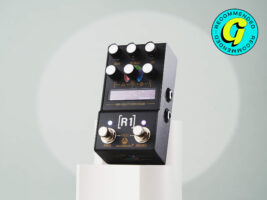
Walrus Audio Mako Mk II R1 review – makes a whole lot of sense for the space conscious reverb fancier
$399, walrusaudio.com
Walrus Audio’s Mako range was one of the trendsetters in the realm of cramming the monster power of high-end DSP into a compact and pedalboard-friendly package, and five years later it seems like even your morning bagel comes with a SHARC chip crammed into there somewhere, so they must have been onto something.
READ MORE: Walrus Mako M1 MKII High Fidelity Modulation Machine review – “some of the very best sounds out there”
It’s entirely fitting then that a few years on from their initial launch, the Oklahoma City-based maker took another swing at the concept – refining, enhancing and elevating the Mako concept in response to player feedback.
While the initial Mako range came out in batches over a couple of years, last year the brand dropped the Mk II versions of the entire range – which is a roundabout way of explaining why it’s taken us quite so long to get around to reviewing this final pedal in the range, the R1 Reverb.
And in truth, I shouldn’t have waited so long, because this Mk II might be the most transformative entry in the whole collection.
Image: Adam Gasson
Walrus Audio Mako R1 Mk II – what is it?
Like its forebear, the R1 is a compact high-end reverb pedal with six distinct reverb ‘programs’ on board. These comprise the vanilla trio of spring, hall and plate, and then three of the more esoteric ambient reverbs that are all the rage these days – air, refract and BFR (which stands for big flippin’ reverb to those of us of a more evangelical persuasion).
Interestingly, Walrus claims that all six of these programs have been “rebuilt and revamped for vast tonal improvement” – that’s a much more bold claim than on any of the other Mk IIs, which talked about only minor tweaks to the sounds if they mentioned anything about it at all.
Perhaps this is because of the original four Mako pedals, the R1 was perhaps the least impressive – in a world overflowing with expensive high-end reverb pedals that do all manner of post-rock things, the core sounds were good but not great, as Richard’s review reflected. The R1’s sounds have been “completely reimagined from the ground up” according to Walrus, offering highly tuned EQ and more parameters and features to tweak.
Image: Adam Gasson
The tweaking of these new parameters comes courtesy of the new OLED screen, which replaces the bank of mini-toggles on the Mk I as is the case with all the revamped Mako pedals.
Elsewhere, MIDI-botherers will be delighted/dismayed (delete as appropriate) to hear that the cumbersome full-size in and thru cables on the original have been swapped for mini-TRS versions here. Yes you’ll need some connectors now, but it certainly makes life neater and prettier from a cable management perspective – and truly, what matters more in pedalboard circles than having a neat and tidy undercarriage?
You’ll also get access to all 128 onboard presets via the pedal’s menu (as opposed to just nine on the original) – and if you really feel like you need more than that, seek professional help immediately.
Image: Adam Gasson
Walrus Audio Mako R1 Mk II – usability and sounds
My biggest gripe with the M1 Mk II that I reviewed a while back was that the replacement of a few toggle switches with a screen to represent multiple different parameters took some of the WYSIWYG brilliance of the originals away.
That’s definitely still the case with the R1 – you’ll certainly want to consult the manual before diving in to determine what you’re doing – but the nature of reverb means that it’s not too much of a learning curve here, with most of the parameters being pretty straightforward.
One of the bigger criticisms of the Mk I R1 was that while it’s out-there stuff was special, it somewhat phoned in the more basic stuff, and you can really sense that Walrus has taken this to heart when you turn the knob to the spring reverb mode.
It’s a responsive and spanky reflection of a classic amp tank rather than anything more bespoke, but there’s a depth and lushness to the recreation here that feels more impressive than the original’s. It’s not the most out-there spring I’ve ever heard but you can use the decay control to push yourself outside the realms of what would be possible with a real spring reverb.
Image: Adam Gasson
It’s fun, if somewhat limited in its everyday utility, but it does give me the opportunity to play around with some of the new parameters that are common for each reverb mode. On the left hand encoder you can tweak the rate and depth of the verb, and you also get a control to set the amount of diffusion on your repeats. A new addition is an expanded version of the swell control which also now allows you to duck your reverb – it’s a nice added extra, especially for the more esoteric sounds.
On the right hand side you can tweak the size of the room you want your verb to verb into, and you also now get the ability to tweak the low and high frequencies of the reverb itself. There’s also a bipolar EQ filter that will tweak the decay to be either darker or brighter depending on which side of the knob you’re twisting it to.
The other two ‘normal’ modes have also had a definite facelift – there’s a real organic quality to the way the room sound’s notes decay, while the plate has a really pleasant diffusion that gets more enjoyably wiggy as you expand the size of the plate.
Walrus’ reputation as purveyors of some of the most excitingly atmospheric reverbs was very evident in Mk I – there wasn’t a damn thing wrong with any of those sounds really – and while the improvement is definitely there in terms of fidelity and depth, the jump in quality is perhaps understandably less noticeable.
The BFR remains ironically named given that it is the most worship-appropriate reverb sound on the pedal – a giant lush, skyscraping sound that begs for plaintive single-note refrains, especially when you diffuse the trails to add even more ethereal vibes. Granular reverb is all the rage these days, and while Refract isn’t going to give the Qi a run for its money in that regard, it adds some fun glitchy grainy textures over a reverb sound that’s heavy on the diffusion. Finally you get the obligatory shimmer verb in Air. This is the sound that has the most unique parameters, namely the ability to tweak how much shimmer you have, and also whether it shims pre- or post the reverb tank. It’s massive and majestic and twinkly in all the ways you’d expect a Walrus reverb to be, and the ducking and swell controls really come into their own here to make the sound bloom and soar in that most ethereal way.
Walrus Audio Mako R1 Mk II – should I buy one?
There’s no escaping that $400 is a whole heap of beans for any pedal, but this has a versatility and round-the-park quality that few other pedals at this price point can match. You may well be tempted to splurge another hundred bucks or so on a big box unit from Strymon or Empress – or to get something that’s more focused (and candidly better sounding) from Universal Audio. But each of those options involves a compromise in terms of pedalboard real estate or variety of sounds… or both.
While I will go to my grave not understanding why Walrus didn’t just name this the R2 rather than the R1 Mk II, pretty much everything else about it makes a whole lot of sense for the space conscious reverb fancier. It’s the most compact and efficient way to go from basic verbs to heavenly choral excess without any real sonic compromises.
Walrus Audio Mako R1 Mk II – alternatives
Most of the R1’s more compact competitors tend to be more specialised, but one that will give it a run for its money is the Strymon BlueSky Mk II ($379) – it’s more tailored towards the three classic verb sounds, but with switchable shimmer and modulation, you can get some really magical sounds out of it. If space isn’t a concern and you want your reverb sounds to come with zero compromises and all the sounds you could ever dream of, then Strymon’s BigSky MX ($679) – it’ll cost you though! Another comprehensively excellent big box reverb is the Empress Reverb ($494) which is a bit long in the tooth now, but still a monster pedal.
The post Walrus Audio Mako Mk II R1 review – makes a whole lot of sense for the space conscious reverb fancier appeared first on Guitar.com | All Things Guitar.
Source: www.guitar-bass.net











